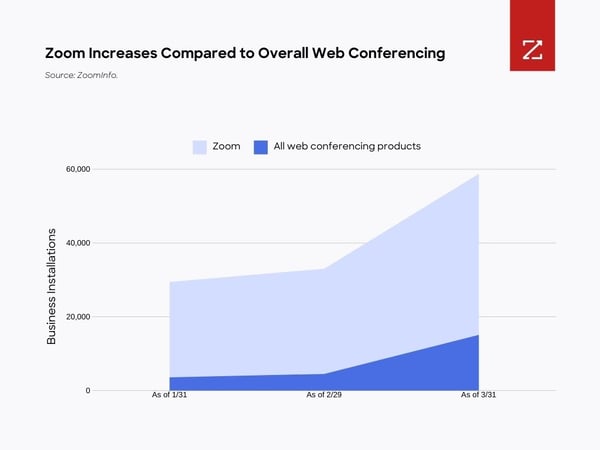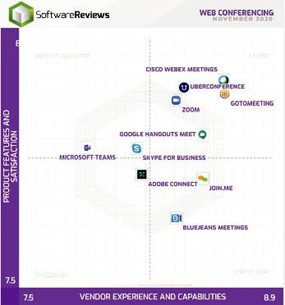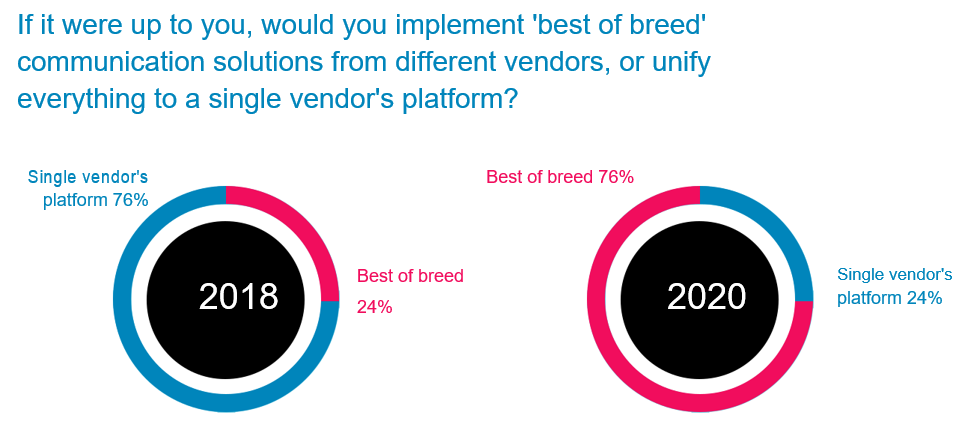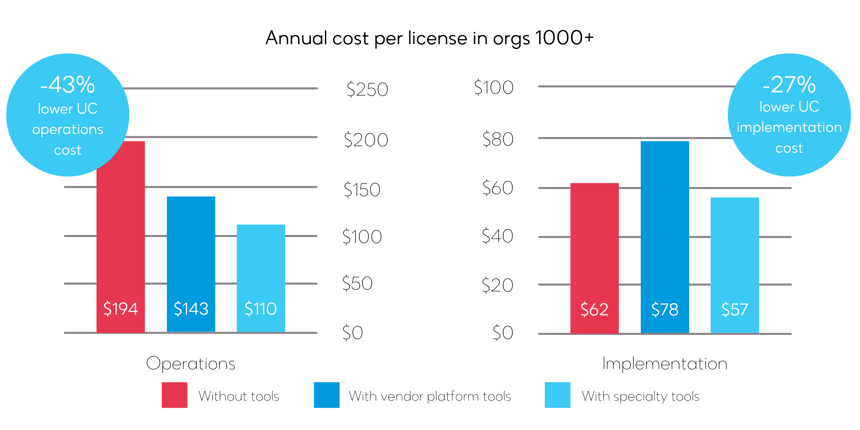With the global workforce in its current state of upheaval, unified communications and collaboration (UCC) is the adhesive holding the workplace - and in large part the economy - together.
There’s no doubt video meeting and conferencing platforms are enabling business continuity and fueling corporate growth. According to Global Market Insights Inc., it’s estimated the UC conferencing market is set to grow at a 14% annual rate, to $20 billion by 2024.
The need for video conferencing across corporate enterprises, government organizations, educational institutions, and healthcare providers is now not just the norm, but a necessity.
There are many UC vendors offering cloud-based video communication and collaboration solutions, like Microsoft Teams, Cisco WebEx Teams, and, of course, Zoom.
Zoom has been growing in usage over the past few years, but stay at home orders saw Zoom’s popularity skyrocket, almost overnight.
 Source: Zoominfo May 2020
Source: Zoominfo May 2020
In the early stages of the COVID pandemic, Zoom usage increased nearly 700% in just a few months. And the usage of Zoom in enterprises is increasing dramatically as well.
To that end, we’ve put together this comprehensive guide to help enterprises considering Zoom as part of their UC collaboration solutions.
Table of Contents
Download a PDF version of our Zoom guide: An essential guide for Zoom Enterprise Deployments [Ensuring Success at Scale]
How Zoom is Bringing the World Together
Innovative communications platforms like Zoom have allowed video conferencing to become a major part of an organization’s daily working environment. So much so it’s impossible to imagine any business being able to function without a reliable meeting and video conferencing platform.
Microsoft Teams, Cisco WebEx Teams, Google Meet and Zoom are all top contenders in this thriving market.
Each platform has its own combinations of features, strengths and weaknesses. It’s important for organizations to identify exactly what they need so IT and security teams can choose the appropriate tools to meet their requirements. For example, Microsoft Teams is tightly interwoven with Microsoft 365. So, for those organizations already using Microsoft 365, it may be the logical choice and the simplest way to integrate productivity software and collaboration tools for seamless unified communications and collaboration.
However, Zoom’s extremely intuitive features and interface have made it one of the most popular choices among organizations and users alike.
Zoom’s user-friendly features
With a reliable and easy-to-use cloud platform, flexible software configuration options, and no hardware lock-in, it’s no surprise Zoom is becoming a leader in enterprise video communications. Zoom’s foundation is built on bringing businesses and organizations together in a frictionless communication environment, to facilitate connection and productivity.
Zoom’s flexible platform offers enterprises a range of features and functions that support video, audio, live chats, screen sharing, one-on-one meetings, group conferences, and recording. Let’s look at some of Zoom’s popular features.
Zoom Meeting
Zoom Meeting is a revolutionary meeting platform that integrates high-quality video and audio support to all your meetings. Zoom Meeting enables enterprises to host online video meetings easily. All a participant needs to do is install the Zoom meeting client on desktop or mobile and join the meeting, no matter where they’re located. Participants can share a video, document, or other files with other participants.
Zoom Meeting features:
- Accessibility. One of Zoom’s biggest benefits is its accessibility. Setting up a Zoom Meeting is as easy as clicking an invitation link to launch the app or prompt users to install the interface, which works well on both desktop and mobile devices. Zoom also offers high quality audio and video, and lightning quick functionality at every price point.
- Scheduling. You can schedule meetings in advance from the Zoom app, which connects to other calendars including Google and Microsoft.
- Advanced features. Zoom is continually updating and improving its technology, offering things like virtual backgrounds, which superimpose over your existing meeting room (which if working from home may be your messy living room). It also has some features that are more whimsical than necessary, like a ‘Touch Up My Features’ facility which enables users to soften their appearance on camera.
- Immersive host controls. This gives hosts excellent control over how the meeting is being conducted. It allows for the creation of a co-host, with additional access to desktop sharing and hand-over controls.
- Engagement features. Zoom has features like filters, lighting, noise cancellation, and additional control over presentations. These features create a more relaxed, natural atmosphere, and add a fun element to virtual meetings to facilitate an in-office environment and help keep participants engaged.
- Meeting capacity. Free and Pro plans allow 100 participants. Business plans start at 300 participants, and can be upgraded to 500 or 1,000 participants per meeting. The screen will show up to 49 participants at once in gallery view. If there are more participants, you can click or swipe the arrow on the side on the screen to see them.
- Breakout rooms. With this function, smaller groups can "break out" from larger meetings, to allow different discussions to take place within an broader topic, encouraging open collaboration and simulating real-world group work.
Zoom Room
While Zoom Meeting is a software that enables the easy conduct of online meetings, a 'Zoom Room' is a software defined solution for physical meeting spaces (like huddle spaces, conference rooms, event spaces). Zoom Room allows users to schedule, launch, and run Zoom Meetings with the push of a button. It can instantly turn a huddle room, meeting room, training room or any other room into a full-functional video conferencing room integrated with high-quality audio/ video capabilities on the Zoom cloud platform. Zoom Room enables users to meet with remote participants on mobile, desktop or even other external conference systems.
Zoom Room conferencing allows users to access a range of different hardware options to suit your preferences.
Zoom Room features:
- One-touch meeting connection
- Built-in security system
- One-click wireless sharing
- Co-annotation whiteboards
- Scheduling displays
- Remote management and software provisioning
- Room and location hierarchies
- Role-based administration
Zoom Webinars
In a Webinar plan, users can have up to 100 panelists with video, audio, screen sharing, and other engagement features. These panelists can present to up to 10,000 view-only attendees. Zoom also offers smaller Webinar plans starting at 100 attendees. These attendees can see and hear the webinar content, but can’t be seen and heard themselves unless they are upgraded to panelist by the webinar’s host.
Like other Zoom solutions, webinars can be set up with branded emails and registration forms. There are also multiple CRM system integrations.
Zoom Webinar features:
- Event assistance from Zoom specialists
- Auto-generated transcripts
- On-demand or recurring webinars
- Reporting and analytics on attendees, and engagement
- Host controls like mute/unmute and more
- Q&A and polling features
- Instant chat for attendees and presenters
Zoom Phone
Zoom Phone is a cloud-calling VoIP solution designed for Zoom users who want quick calling without video. With Zoom Phone, Zoom becomes a comprehensive, full-featured communication and collaboration product. Enterprises can consolidate their business communications and collaboration solutions and even replace their PBXs.
Zoom Phone features:
- An intelligent call management and routing facility
- Auto attendant and IVR tools to route calls to the right agents
- State-of-the art apps for both mobile and desktop devices
- Call recording and voicemail
- Interoperability with standards-based endpoints.
Zoom Chat
Zoom Chat keeps teams connected by offering streamlined instant messaging, as well as integration with all of Zoom’s most popular tools. Intelligent search is built-in, and Chat allows one-on-one or group chat.
Starred channels and contacts allow you to keep track of participants, with status and presence features showing who is online. Zoom Chat also has a security and archiving feature for compliance, and calendar integrations.
Why Zoom’s popularity with enterprises is growing

Source: Infotech Research Group
Up until recently, there have been limited options for comprehensive video conferencing solution for enterprises that promises and delivers crisp video, reliable sound quality and ease of use (seamless joining, participating, screen sharing, annotations etc.).
With its supremely reliable and intuitive user interface, Zoom’s software has been engineered and optimized to provide the ultimate user experience. Users report they find it easy to navigate across all their devices.
Unlike some of its competitors, Zoom doesn’t require new or occasional users to download extensions or wait to join meetings. Also, Zoom’s one-touch feature is consistent across all endpoints, allowing users to join or start a video conference or meeting across several devices.
According to Infotech Research Group, Zoom is amongst the top four most popular web conferencing platforms with users driven by their perception of the increased business value it helps create, and its breadth and quality of features.
Zoom also received high scores for ease of IT administration, jumping from 69% to 82% between 2019 and 2020. Zoom users also say ease of data integration has improved, increasing from 75% in 2019 to 80% in 2020.
While Zoom can be activated instantly on its own cloud, organizations can also deploy Zoom as a hybrid service with meetings hosted in their private cloud by using Zoom Meeting Connector. With the ability to scale capacity quickly and easily, and failover and load-balancing features built in, Zoom ensures reliability and consistency.
Zoom’s Intuitive App Integration Features
One of the challenges of a remote workforce is the diversity in user operating systems and applications. Zoom is available on Windows, macOS, iOS, Android, ChromeOS, Linux, and as a web client. Amongst Zoom's best features is the long list of integrations and apps available on every operating system.
Zoom Rooms can be invited to join meetings with third party meeting services like Skype for Business, Microsoft Teams, WebEx, GoToMeeting, Google Hangouts with one click. This is useful for organizations migrating to Zoom from other video conferencing solutions or who work with vendors and customers who use 3rd party meeting services. There are many more third-party apps that integrate with Zoom.
Microsoft Teams
With its app for Microsoft Teams, Zoom becomes a tightly integrated part of the Teams app. Once installed, it adds a Zoom tab to Teams and Zoom meetings launched from inside the Microsoft Teams app. One-click ad hoc meetings are also possible, and meetings can be joined or started using an @mention as well.
Microsoft Office 365 and Outlook
Just about every enterprise organization uses Microsoft Office 365 and Outlook. With the Zoom integration you can add a Zoom meeting to any new or existing calendar event with one click, schedule and start instant Zoom meetings, and sync free/busy times to the Zoom Client based on your Outlook Calendar events.
Gmail
Zoom users can schedule meetings directly from Gmail, which means there is no need to learn a new user interface to get going with Zoom. Once installed, an add-on button in Gmail can be used to schedule meetings, invite users, and start meetings from inside Gmail without the need to open the Zoom app.
Slack
Similarly to Gmail, Zoom lets Slack users schedule, start, record, join, and do many of the functions of the Zoom app from inside Slack. Individual users can add Zoom to Slack themselves, or enterprises can configure the add-on to be a part of standard Slack install packages.
Salesforce
The Salesforce Zoom app offers features that make meeting with teammates, clients, and leads only a few clicks away. Some of those great features include automatic logging of Zoom activity in a user's Salesforce history, integration with Zoom Phone, meeting recording that stores in Salesforce, automatic campaign creation, and more.
OneLogin
OneLogin's Zoom tool is designed for enterprise administrators who want to make Zoom a single sign on (SSO) portal. Enterprises will find this a valuable tool that makes Zoom more secure while at the same time making it a powerful SSO tool.
Evernote
Evernote has a Zoom integration that makes it possible to create, edit, and store Evernote documents from inside Zoom.
Zapier
Zapier can integrate with Zoom in several ways. It can automate tasks like sending invitations when creating a meeting, automatic webinar registration upon customer payment, and more. Zapier said it has over 1,500 app integrations that can connect to Zoom through its platform, so it could be a valuable tool for enterprises.
Deploying Zoom at Scale
Organizations thinking about using Zoom as an IT approved platform will need to consider any specific standardization expectations. Interoperability, budgeting, training and adoption, security and end-user support needs must all be put into the mix when adopting Zoom at scale.
Ensuring user adoption
One of the most important considerations for businesses adopting new technology is the people aspect. Many employees may be comfortably familiar with using other web conferencing facilities, or entirely uncomfortable using any at all.
So how will the integration of Zoom collaboration tools affect the daily life of your employees? One of the key drivers for Zoom’s popularity is its ease of use, but there are still several considerations. Fast, seamless user adoption ensures rapid return on investment, but to achieve it, IT departments must plan well and be in control every step of the way.
Security issues
Anyone already familiar with Zoom will know that along with its surge in popularity came some well publicized security breaches and encryption problems when its platform was infiltrated in unexpected ways. ‘Zoom-bombing’, the latest patois in the tech communications vernacular to describe the unwanted, disruptive intrusion, generally by Internet trolls into a video conference call.
Zoom’s CEO Eric Yuan took immediate action, tightened security, overhauled encryption processes, and made public the further steps being taken to address the glitches. But the responsibility for securing teams and data in this new culture of remote working is also the responsibility of corporate security teams.
Large organizations could have potentially hundreds or even thousands of virtual meetings being conducted at any given time, and in various formats, so it’s important to have strict user control permissions in place. Zoom’s updated, enhanced controlled privacy and security settings reduce the chance of unknown or unwelcome guests from infiltrating a meeting or webinar.
Features like meeting passwords, session locks, sharing limitations, participant removal and waiting rooms allow managed permissions and controlled access to meetings and information.
Optimizing Zoom’s Performance with Third-Party Monitoring Solutions
With the massive increase in workplace sprawl, and the upsurge in use of video conferencing platforms like Zoom, one thing many organizations have been struggling with is the increased level of expectation and demand this places on IT and help desk resources.
Performance and experience management tools are invaluable in managing some of this increased pressure. Not only to proactively improve user experience and satisfaction levels, but to provide a tangible cost reduction.
These tools become even more important when used in the multi-vendor environment most enterprises are operating in.
According to Wainhouse Research, more than three quarters of IT leaders would choose to implement a range of “best of breed” solutions from a variety of vendors to meet their UC requirements, rather than unify everything under a single vendor.

Source: Wainhouse Research: Managing UCC Complexity in Complex Times

Source: 2019 Annual UCC Total Cost of Operations Report, Nemertes Research
Organizations are now also supporting meetings and calls across multiple user devices in the office and at home, including laptops, smart phones and tablets, desk phones, soft phones, video clients, USB and audio devices and much more.
The pressure to deliver a good user experience is always high. But there are many complexities to consider. Internal network routing can include proxies, security services, central internet bandwidth, backhaul multiprotocol label switching (MPLS) circuits, network address translations, and more.
When users work remotely, collaboration platforms become harder to support in the event of a performance issue. IT teams need to first understand the scope of the problem, then consider its origins before they can act.
For example:
- Is it only one user, or multiple users having issues?
- What is the root cause of the problem?
- Is it the internal network?
- Could it be the user’s home wi-fi?
- Is the problem related to the user’s laptop?
- Is it the VPN?
- Or is it something to do with Zoom itself?
Network assessments also provide visibility so you can quickly identify weak points and trouble areas in your complex network configurations. Performance management tools are the best form of insurance and peace of mind your entire UC ecosystem is being monitored, analyzed, and optimized - and any problems can be dealt with proactively.
Using Analytics to Track Zoom's Performance
The consensus from users is Zoom offers a greater level of ease of use and adoption, which has been a big factor in its rising popularity. It also ticks a lot of boxes for IT administrators, with its entry-level monitoring tools. It provides a built-in cloud-based suite of admin tools for monitoring, with additional system and data reporting and backup services, as most collaboration platforms do.
But what if you’re in the process of migrating to the cloud, or operating in a hybrid environment, as well as using multi-vendor UC solutions? There are some crucial, and non-negotiable factors to consider. The ability to resolve issues quickly and efficiently, and troubleshoot across the entire ecosystem – and not just for one vendor – is vital. Having a tool in place that spans multiple systems and can monitor and troubleshoot across multiple vendors and devices will save a great deal of valuable time and ensure business continuity.
Insights gained from using analytics is essential in understanding your organizations Zoom usage. You can determine things like:
- How many people within the organization are using Zoom daily?
- How many Zoom Rooms and channels have been created?
- How many meetings are being held per month?
- Who are the top users?
- Where are the top users based?
The answers to these questions are essential to establishing adoption and return on investment (ROI). This information is also invaluable when it comes to developing IT strategy, capacity planning, and identifying where upgrades or further training might be required.
As mentioned, Zoom does come with native reporting tools, but for more meaningful, contextual, actionable insights, you need specialized monitoring and analytics capabilities.
Some technical tips to consider
Monitor the details that affect the conference experience. Any online meeting is susceptible to call issues like disconnection and bad audio quality, poor and unstable screen share, and video quality. The ability to identify these issues quickly is vital to the user experience. Third party monitoring tools can see the number of times these issues have occurred across the Zoom platform and provide statistics gathered on Meeting and Webinar issues.
Know your host. Third party tools can analyze the type of meetings and the host who conducts them. This will help you understand Zoom usage patterns in an organization, and optimize usage.
Ensure safe, secure Zoom Rooms. Monitoring allows you to gather statistics on meetings held without passwords, without enforced logins, and without waiting rooms.
Analytics can identify how connections are made and show breaches of security to keep meetings and conferences secure.
Keep track of meeting durations. Monitoring tools can set up alerts for anything from meetings exceeding a set time, additional users joining without passwords, zero attendees in a Zoom Webinar, high CPU utilization during a particular meeting and other issues.
Download a PDF version of our Zoom guide: An essential guide for Zoom Enterprise Deployments [Ensuring Success at Scale]
Conclusion
Zoom is a powerful, intuitive, flexible, and cost-effective UC solution for enterprises. It delivers a wide array of features that enhance communication and collaboration between employees, clients and customers anywhere in the world.
Zoom provides a way to ensure business continuity, while offering a true unified communication experience across existing business solutions and applications.
Like all collaboration platforms, they often run across multiple networks and carrier services, on premises, in the cloud and hybrid. Every organization is different, but unified communication platforms like Zoom are enabling businesses and workforces to come together seamlessly.
Having a third-party tool in place to manage, monitor, troubleshoot, and provide insight into complex enterprise UC environments is critical to ensuring seamless connection, fast problem resolution, a positive user experience, and ultimately, overall success with Zoom.





